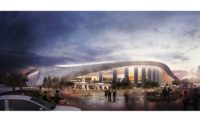Top 500 Design Firms Sourcebook
Environmental Sector Shows Strength, Despite Slow Starts

San Diego’s Pure Water program includes reverse-osmosis units (above) and water reuse.
Many top design firms report continued strength in environmental markets, particularly in the water and wastewater sectors. A wide variety of project types, from traditional to innovative, are moving forward, despite some hesitancy by water authorities to negotiate and sign contracts.
Peter Nicol, president of CH2M’s water business, says the firm has seen more opportunities across North America in both the public and private sectors, with numerous large projects out for proposals. “The challenge is that, although the jobs are out there ... jobs are slow to get going,” he says. “You have the work, but you’re not really moving your teams along quickly, and there’s not a lot of urgency on the receiving end.”
Marshall Davert, MWH Global president of government and infrastructure for the Americas and the Asia-Pacific region, says procurement activity has been high during the past two years, but there is a “lag in converting wins into revenue.”
Davert says 2015 was one of MWH’s top years in generating backlog, and the firm set a new record for first-quarter wins this year. But many municipal clients “are moving with tentativeness just to make sure the economy has picked up and they will have the funds for infrastructure,” he says. Davert expects the company to tally strong revenues in 2017, largely due to its recent string of contract wins and Stantec’s recent acquisition of the company, announced in April. He says the two firms complement each other, with limited redundancies in the water and wastewater markets. “When we combined the top-25 clients of each, we only saw four overlapping clients,” he says.
CH2M’s Nicol is optimistic that alternative delivery methods will continue to drive new opportunities. “There’s more variety in the relationships that all of our competitors [have] with clients today,” he says. He sees a continued trend toward the adoption of progressive design-build methods, which allow owners more interaction in the design phase before finalizing a lump-sum contract. In May, a joint venture of CH2M and CDM Smith was selected as the
design-build team to deliver the $1.2-billion Northeast Water-Purification Plant Expansion for the city of Houston.
Nicol also sees increased interest in public-private partnerships. “We’re not seeing [clients] embracing it, but we’re seeing requests for expression of interest, qualifications and consideration,” he says. “There’s a lot of discussion in the marketplace that we need money, and this is a way to get money. Then, they start to look into it, and it’s a lot more complicated … [and] that’s why we haven’t seen deals flow in the marketplace.”
Interest in direct and indirect potable reuse projects—such as facilities being designed as part of San Diego’s Pure Water program—continues to grow, particularly in California and Texas. “We’re really excited about the progress reuse is making in our thinking in the public and accepting direct potable and indirect potable reuse,” says Mike Orth, an executive vice president at Black & Veatch.




